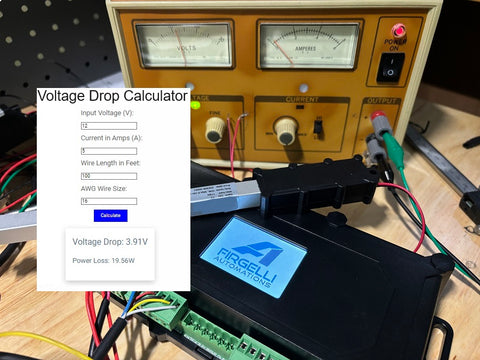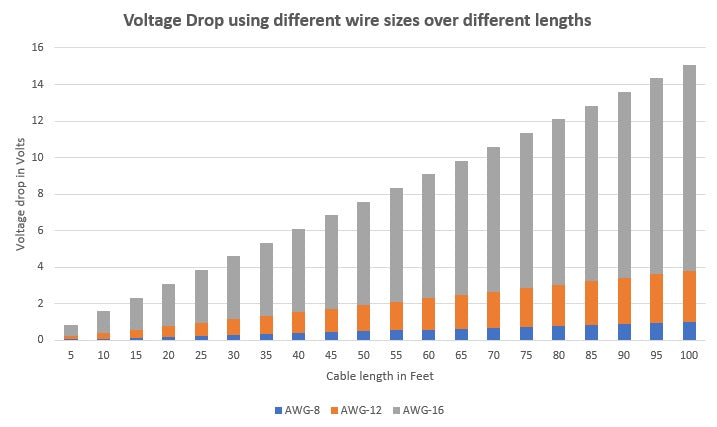Introduction
Understanding how electricity flows is essential, especially when you’re working with FIRGELLI electric linear actuators. Sometimes, as electricity travels through wires, it faces resistance and loses some of its strength - we call this a "voltage drop." It’s a normal occurrence, but it’s something that needs to be considered to ensure that your actuators work efficiently and safely.
This guide is here to help explain what voltage drop is, why it happens, and what you can do about it. We know that some of you might be using different lengths of wire to set up your actuators, and that’s where the concept of voltage drop really comes into play.
We’ve included an online calculator tool in this post to make things easier. It’s straightforward and helps you figure out how different wire lengths can affect the performance of your FIRGELLI actuators. So, you don’t have to be an electrical wizard to get it right - we’ve got you covered.
In a nutshell, this post is all about making sure you have all the information you need to get the best out of your FIRGELLI electric linear actuators, keeping them running smoothly and safely.
To go direct to the calculator, go to the bottom of the page
Understanding Voltage Drop
Electricity flows through wires, pushed by voltage. However, the wire resists the flow of electricity to some extent. This resistance causes a reduction in the voltage as electricity travels along the wire, a phenomenon known as voltage drop.
What Causes Voltage Drop?
Voltage drop is mainly caused by the wire’s resistance. In alternating current (AC) systems, this resistance combined with the reactance (due to the alternating nature of the current) is referred to as impedance.
Effects of Voltage Drop
A significant voltage drop can lead to a slower Actuator speedm and less force, ineffective heaters, and motors overheating and failing. To avoid this, it’s generally advised to keep the voltage drop below 5% of the total voltage, especially in fully loaded circuits.
Factors Influencing Voltage Drop

Material of the Wire
The type of material a wire is made of significantly impacts its conductivity. Materials like copper and aluminum are commonly used because they are excellent conductors and are cost-effective. Among them, copper has a lower resistance compared to aluminum.
Wire Size

The size of the wire also plays a crucial role. Bigger wires with larger diameters have less resistance, leading to a lower voltage drop. The measure of a wire's size is referred to as its gauge. We have included an AWG guide below, and if you play around with the Voltage drop calculator below you will notice the wire Guage has the greeates effect on the voltage drop.
Length of the Wire

Longer wires experience a higher voltage drop. It’s especially vital to consider the wire’s length in extensive wiring systems, like those connecting outbuildings or well pumps.
Current Carrying Capacity
The amount of current a wire carries also influences the voltage drop. Higher current leads to a higher drop. The wire’s ability to carry current is termed its ampacity, which is influenced by factors like the wire’s material, the current’s frequency, and operating temperature.
Temperature and Cable Bundling
Wires operating at higher temperatures and those bundled together can experience increased resistance and, subsequently, a higher voltage drop. Proper cable selection and adherence to bundling rules can mitigate these issues.
In Summary - Causes of Voltage Drop:
-
Material of the Wire: The material used can determine its electrical conductivity. Silver, gold, copper, and aluminum are top contenders, with copper and aluminum being the most commonly used due to cost-effectiveness. Copper outperforms aluminum in conductivity.
-
Wire Size: A larger wire (in diameter) will have a lesser voltage drop compared to a smaller one of the same length. In the American Wire Gauge (AWG) system, a decrease of 6 gauges doubles the wire diameter, and a decrease of 3 gauges doubles the wire's cross-sectional area. Unfortunately it is confusing that the smaller the AWG wire size the larger it actually is in diamter, so please remember this.
-
Length of the Wire: Shorter wires have less voltage drop compared to longer wires of the same size. This becomes crucial when wiring longer distances, like to an outbuilding.
-
Current Amount: More current flowing through a wire results in a greater voltage drop. The ampacity (maximum current capacity) of a wire can be influenced by its material, ambient temperature, and how closely bundled it is with other cables.
Calculating the Voltage Drop:
lets go into the detail of the calculator, you can skip this section if you like and go directly to the calculator below.
At its core, Ohm's Law provides the foundation for calculating voltage drop:
Where:
- : Current through the wire (in amperes)
- : Resistance of the wire (in ohms)
For circuits with direct current:
Here, stands for the length of the wire.
American Wire Gauge (AWG) Sizes:
The AWG system is a standard used in North America to specify wire diameters. Below is a table showcasing various AWG sizes and their associated specifications:
AWG Wire Sizes - with Resistance figures
| AWG | Diameter (inch) | Diameter (mm) | Area (kcmil) | Area (mm²) | Resistance (Ω/km) | Resistance (Ω/1000ft) |
|---|---|---|---|---|---|---|
| 2 | 0.2576 | 6.544 | 66.4 | 33.6 | 0.5127 | 0.1563 |
| 4 | 0.2043 | 5.189 | 41.7 | 21.2 | 0.8152 | 0.2485 |
| 6 | 0.1620 | 4.115 | 26.3 | 13.3 | 1.296 | 0.3951 |
| 8 | 0.1285 | 3.264 | 16.5 | 8.37 | 2.061 | 0.6282 |
| 10 | 0.1019 | 2.588 | 10.4 | 5.26 | 3.277 | 0.9989 |
| 12 | 0.0808 | 2.053 | 6.53 | 3.31 | 5.211 | 1.588 |
| 14 | 0.0641 | 1.628 | 4.11 | 2.08 | 8.286 | 2.525 |
| 16 | 0.0508 | 1.291 | 2.58 | 1.31 | 13.17 | 4.016 |
| 18 | 0.0403 | 1.024 | 1.62 | 0.823 | 20.95 | 6.385 |
| 20 | 0.0320 | 0.812 | 1.02 | 0.518 | 33.31 | 10.15 |
| 22 | 0.0253 | 0.644 | 0.642 | 0.326 | 52.96 | 16.14 |
| 24 | 0.0201 | 0.511 | 0.404 | 0.205 | 84.22 | 25.67 |
| 26 | 0.0159 | 0.405 | 0.254 | 0.129 | 133.9 | 40.81 |
| 28 | 0.0126 | 0.321 | 0.160 | 0.0810 | 212.9 | 64.90 |
In Conclusion:
Voltage drop is a crucial aspect to consider when setting up electrical circuits. By choosing the right wire material, size, and being aware of the wire length and current, you can minimize voltage drop and ensure your electrical devices function efficiently and safely.
Try the Voltage drop Calculator below
Before you try the calculator below, lets review the calculations that go into the online calculator. Lets assume we want to know what the power and voltage drop is over a 50-foot length of copper wire, with a 12v DC input, and 12Amps input using a wire size of AWG-12. The calculations are as follows:
- Voltage = 12V
- Current = 12A
- Wire length = 50ft (instead of the previous 1000ft)
- Wire size = 12 AWG
Let's go through the calculations:
- Resistivity for copper () is .
- The wire length is converted to meters: .
- The diameter of the wire for 12 AWG is calculated as , which is then converted to meters.
- The cross-sectional area is calculated using the formula for the area of a circle, .
- The resistance of the wire is calculated using .
- The voltage drop is calculated using the formula .
- The power loss is calculated using the formula .
Now, plugging in the values:
For a cable length of 50', given the other inputs as specified, the calculator should yield a voltage drop of approximately 1.865V and a power loss of approximately 22.38W.

